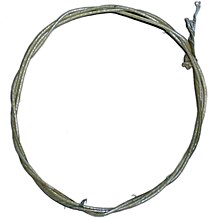Catgut
Catgut (also Katgut , pronounced [ˈkɛtɡat] or [ˈkatɡʊt] , rarely also cat intestines ) denotes strings or threads made from sheep and other natural intestines .
Origin of the term
The etymology of the term is doubtful. Possible explanations are a contraction of cattle gut (“ cattle gut ”) or a corruption of kit gut ( kit used to refer to a fiddle or dance master violin , but also means “kitten”).
The medical term "Catgut" was usually not translated into German, where it used to be written "Katgut". It has never been proven that cats' intestines were used for this, as is sometimes claimed.
Use in musical instruments

Use as strings
Strings are still made from sheep and beef intestines today. But they are simply referred to as gut strings and usually no longer as "cat intestines".
Use as frets
Some traditional string instruments, such as the Persian tar , use intestines as frets . Even with lutes and viols, the frets are often made from gut strings.
Technical use
Because of its tensile strength, the material was also used in watchmaking to hang watch weights. Modern, age-resistant materials are available for this purpose today, but it is still used in the faithful restoration of antique clocks.
Use in sports
For various types of racket sports ( badminton , squash , tennis ), natural casing is used to cover the racket. Strings made from natural gut are often of higher quality than plastic strings, but they also lose their excellent properties much faster.
Use as medical sutures
Already Galen (2nd century. Chr.) Reported the use of gut strings for suturing of wounds . Catgut was made from the intestines of highland sheep and, more recently, from cattle collagen . The threads decompose within a few days under the action of the body's own enzymes and are thus absorbed , so they dissolve themselves and do not need to be pulled. At the time of Joseph Lister (1827–1912), catgut (catgut in German-speaking countries) and silk were common in medicine and veterinary medicine . In 1860 Lister introduced catgut disinfected with phenol (then called “carbol oil”).
Around 1900 various sterilization methods for catgut were practiced, including with chromic acid or iodine. However, none of them were completely reliable. In 1908, the pharmacist Carl Braun and the surgeon Franz Kuhn developed a method for the industrial production of sterile catgut from mutton intestine, which laid the foundation for the success of the medical supplies company B. Braun Melsungen .
From 1935 onwards, catgut was replaced as suturing material in human medicine by synthetic threads, which, however, were initially non-absorbable and therefore had to be pulled. But catgut has also not been allowed to be used in veterinary medicine in Europe and Japan since 2001 and 2002, out of caution against BSE . Instead, synthetic absorbable materials are used, which are hydrolyzed solely through the action of tissue water (and without variable enzymatic activities) .
Artisanal catgut production. Etching by Antonio Baratti in Diderot and D'Alembert's Encyclopédie (1768)
Catgut threads laid in phenol ("carbol oil") by Joseph Lister
Sausage production
Even sheep casings , the Pelle different stringed sausages are sometimes referred to as catgut.
Individual evidence
- ↑ Duden Online, entry "Katgut"
- ↑ Jo Nardolillo: All Things Strings. An Illustrated Dictionary. Scarecrow Press, 2014, p. 53, entry gut strings .
- ↑ Raffaella Leoci: Animal by-products (ABPs). Origins, uses, and European regulations. Universitas Studiorum, Mantova 2014, p. 95.
- ↑ Robert Hendrickson: QPB Encyclopedia of Word and Phrase Origins. Facts on File, 1998, p. 133.
- ↑ Cf. for example Dionys von Szabó: About catgut as sewing material. In: Centralblatt für Gynäkologie. Volume 10, No. 25, June 19, 1886, pp. 398-400.
- ^ Markus Plate, Torsten Groth, Volker Ackermann, Arist von Schlippe: Large German family businesses. Generational succession, family strategy and corporate development. Vandenhoeck & Ruprecht, Göttingen 2011, p. 54.
- ^ Hans-Otto Maier: Research and development for medical progress - the contribution by B. Braun Melsungen since the end of the 19th century. In: Health through Technology? Technology and medicine since the end of the 19th century. Pp. 83–92, at p. 84.
- ↑ Raffaella Leoci: Animal by-products (ABPs). Origins, uses, and European regulations. Universitas Studiorum, Mantova 2014, p. 96.
Web links
- Naturalgut on tenniswarehouse-europe.com




